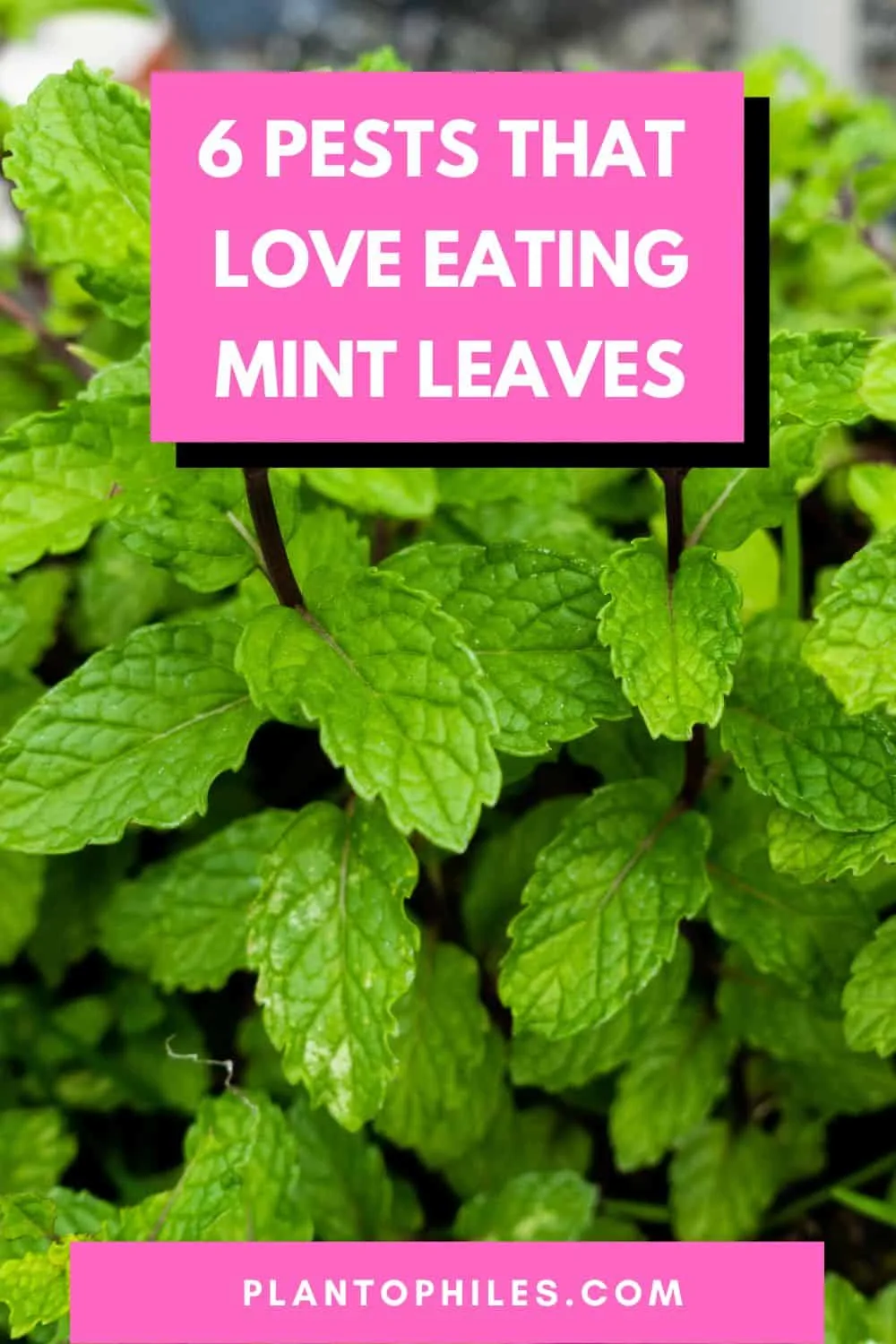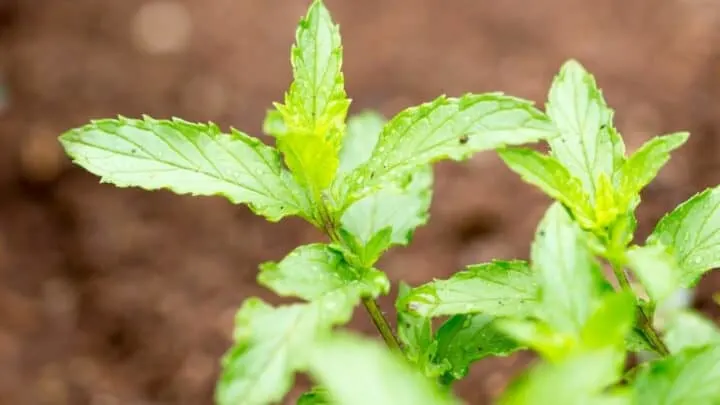Do you love mojitos, or are you a fan of fresh salads? If so, then growing a mint plant is a fantastic idea for you!
There is nothing better than picking your mint and being assured of fresh supply always.
The mint plant is known for its many fascinating properties. It is used for its strong flavor in foods and drinks.
The strong aroma enables us to freshen up our breath and the plant is also used in essential oils to freshen up your house.
Not only do Mint leaves eradicate bad breath, but they are also great natural pest repellents to have in your garden.
The strong aroma from your mint plant will deter many bugs, mice, and ants from infesting close by plants in your garden.
What is eating my mint leaves?
Predators eating mint leaves include flea beetles, spider mites, and aphids. However, it is often difficult to detect what pest is damaging your mint leaves. To find out what is eating your mint leaves, look at the damage pattern. Different pests do different types of damage to your plant.
1. Flea beetles
Flea beetles are small insects that have a brown or black appearance with a slight yellow hint.
They feed on the leaves of your mint plant and cause small holes that can be described as “shot-holes”.
These beetles usually come out during late summer so that is when you need to watch out for the pests!
Adult flea beetles lay their eggs in May. They lay them in the soil of your mint plant and these eggs usually hatch into larvae by June.
The larvae can be even more problematic for your mint plant than fully-grown flea bugs. This is because the larvae feed on the roots and rhizomes of your plant.
If your plant’s roots have been eaten too much then there is a huge possibility your plant will wilt and eventually die.
The adult flea bugs are easier to spot than the larvae as they usually hide on the inside of your plant’s leaves.
If you notice small holes in your mint leaves then I would suggest you regularly inspect your plant for these types of bugs.
Larvae can be seen burrowing in the roots of your mint plant.
If you suspect that there might be larvae eating your plant’s roots then I suggest you thoroughly inspect the roots of your mint plant.
The best way to remedy this issue of flea bug eggs is to cultivate the base of the plant with a gardening hose or spade.
Churn the top layer of your mint plant’s soil. This will cover up and destroy the eggs and larvae.
Diatomaceous powder is a good way to rid your mint of these flea bugs.
Place the powder at the base of your mint plant and all around the soil. This will dry out the full-grown flea beetles and terminate them.
Another remedy you can use is that you can head out to your local gardening center and buy a solution of pesticide especially aimed at terminating flea beetles.
2. Spider mites
These pests come out when the weather gets a bit more humid, so the months of April to July are most likely when you’ll find these insects attacking your mint plant.
They are very small and have a white, transparent body. Spider mites usually nest and feed in large colonies.
These insects usually attack the whole foliage of the plant. They feed on the leaves as well as lay their eggs on the leaves.
If you notice black spots on your plant this is an indication that you might have a spider mite infection, and they have started to lay their eggs on your mint plant.
Tiny webs between the leaves and discoloring of the foliage is another way to identify these pests.
If spider mites are the culprits eating away your mint plant, I suggest you take action immediately as if these pests continue to nest and feed on your plant it will eventually become deformed and the whole plant will die.
A solution of Neem oil and water is one of the best ways to terminate spider mites. Thoroughly spray all the leaves of your mint plant with this solution.
This should be done the most twice, the least once a week, depending on how bad the infestation is.
If the infestation continues then I would suggest you buy a pesticide that is special in eradicating spider mites.
3. Aphids
Aphids are a menace in the garden. These tiny pests attack almost all plants and are so small that sometimes they are very difficult to spot.
Many types of aphids exist, but the black and green aphids are most prevalently seen attacking mint.
Aphids can be an absolute nightmare as they can cause great damage to the foliage of your mint plant.
They feed on the foliage for nutrients, and by doing this, they discolor the leaves as they suck all the leaves’ nutrients out.
This can be an issue as, over time your mint plant will lose all its nutrients. This will cause your plant to become deformed, and leaf curl may happen.
If this issue is left for too long then there is a chance your plant may die.
If you notice any aphids on your mint plant or any aphid damage done to the foliage of your mint plant then it’s time to take action!
Take a high-pressure hose and spray your mint plant thoroughly. By doing this you will physically push off many aphids from your plant.
After this has been done, mix a solution of neem oil, water, and soap together. This solution should be sprayed up to 2x a week, but it depends on how severe the infestation is.

4. Caterpillars
Caterpillars are the larvae of various butterfly and moth species.
Depending on the type, they can vary in size, color, and appearance, but many of them have a voracious appetite, and mint leaves are not exempt from their menu.
When you notice irregular holes or entire portions of your mint leaves missing, there’s a good chance you are dealing with caterpillars.
They tend to feed at night or during overcast days and hide during the daytime, making them somewhat elusive.
The key to combating caterpillars is catching them early.
Regularly inspecting the undersides of leaves can help in spotting and manually removing them.
For natural control, consider introducing beneficial insects like ladybugs or parasitic wasps to your garden.
These predators will then feed on the caterpillars and will, therefore, help you to get rid of them in an effective and organic manner.
Another option is to use Bacillus thuringiensis (BT). This natural bacteria targets caterpillars and causes them to stop eating. As a result, they eventually die.
Now that you know how to get rid of caterpillars on your mint plant, let’s move on to the next culprit, namely whiteflies.
5. Whiteflies
Whiteflies are small, winged insects similar in size to aphids.
More often than not, you will find these pesky creatures on the undersides of mint leaves, and when disturbed, you can see them flying around in a cloud-like formation.
Feeding on plant sap, whiteflies can cause yellowing or a mottled appearance on leaves.
Furthermore, they excrete a sticky substance called honeydew, which can lead to mold growth on the leaves.
To combat whiteflies, introduce natural predators like lacewings and ladybugs.
Yellow sticky traps can also be used as whiteflies are attracted to the color of these traps and get stuck.
Also, a strong jet of water can work wonders and help knock these pesky creatures off your mint plant.
As a more persistent solution, though, consider using insecticidal soaps or neem oil, making sure to spray the undersides of leaves where they primarily reside.
Read more on whiteflies in our article: “Whiteflies on Plants“
6. Slugs and Snails
If you’ve ever ventured out into your garden after a rain or during the early morning hours, you’ve probably come across slugs or snails.
These slimy creatures are notorious for their love of tender plant foliage, including that of the mint.
The damage they cause is evident from the large, ragged holes they chew through leaves. You might also notice their silvery slime trails, a tell-tale sign of their nocturnal feasting.
One popular method to deter these pests is to sprinkle crushed eggshells or diatomaceous earth around the mint plants.
The sharp edges deter them from crossing.
Alternatively, beer traps can be effective. By placing shallow containers filled with beer at ground level, slugs, and snails are attracted to the yeast, fall in, and drown.
Copper tape or barriers are yet another method to win the upper hand against slugs and snails.
When these pests come into contact with copper, it gives them an unpleasant electric-like shock, keeping them away from your mint.

Daniel has been a plant enthusiast for over 20 years. He owns hundreds of houseplants and prepares for the chili growing seasons yearly with great anticipation. His favorite plants are plant species in the Araceae family, such as Monstera, Philodendron, and Anthurium. He also loves gardening and is growing hot peppers, tomatoes, and many more vegetables.


